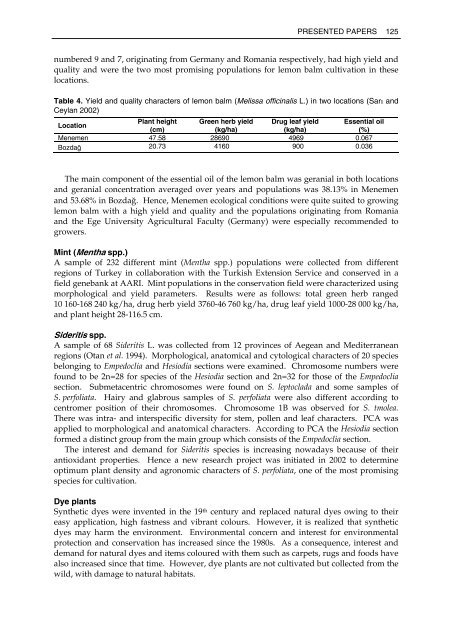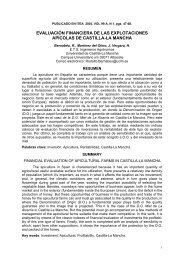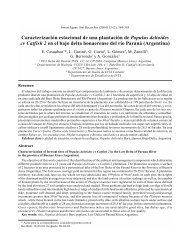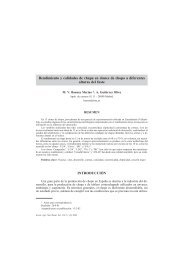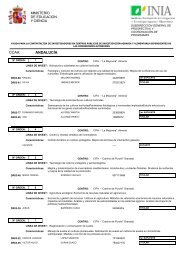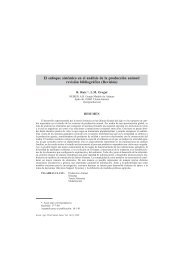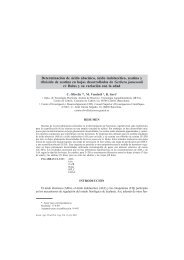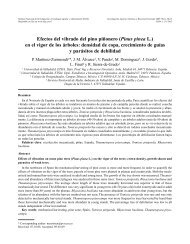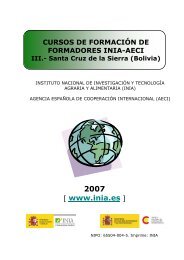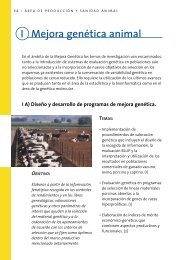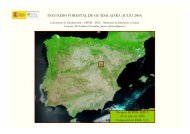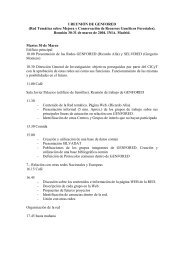Status of medicinal and aromatic plants in - Inia
Status of medicinal and aromatic plants in - Inia
Status of medicinal and aromatic plants in - Inia
Create successful ePaper yourself
Turn your PDF publications into a flip-book with our unique Google optimized e-Paper software.
PRESENTED PAPERS 125<br />
numbered 9 <strong>and</strong> 7, orig<strong>in</strong>at<strong>in</strong>g from Germany <strong>and</strong> Romania respectively, had high yield <strong>and</strong><br />
quality <strong>and</strong> were the two most promis<strong>in</strong>g populations for lemon balm cultivation <strong>in</strong> these<br />
locations.<br />
Table 4. Yield <strong>and</strong> quality characters <strong>of</strong> lemon balm (Melissa <strong>of</strong>fic<strong>in</strong>alis L.) <strong>in</strong> two locations (Sarı <strong>and</strong><br />
Ceylan 2002)<br />
Location<br />
Plant height Green herb yield Drug leaf yield Essential oil<br />
(cm)<br />
(kg/ha)<br />
(kg/ha)<br />
(%)<br />
Menemen 47.58 28690 4969 0.067<br />
Bozdağ 20.73 4160 900 0.036<br />
The ma<strong>in</strong> component <strong>of</strong> the essential oil <strong>of</strong> the lemon balm was geranial <strong>in</strong> both locations<br />
<strong>and</strong> geranial concentration averaged over years <strong>and</strong> populations was 38.13% <strong>in</strong> Menemen<br />
<strong>and</strong> 53.68% <strong>in</strong> Bozdağ. Hence, Menemen ecological conditions were quite suited to grow<strong>in</strong>g<br />
lemon balm with a high yield <strong>and</strong> quality <strong>and</strong> the populations orig<strong>in</strong>at<strong>in</strong>g from Romania<br />
<strong>and</strong> the Ege University Agricultural Faculty (Germany) were especially recommended to<br />
growers.<br />
M<strong>in</strong>t (Mentha spp.)<br />
A sample <strong>of</strong> 232 different m<strong>in</strong>t (Mentha spp.) populations were collected from different<br />
regions <strong>of</strong> Turkey <strong>in</strong> collaboration with the Turkish Extension Service <strong>and</strong> conserved <strong>in</strong> a<br />
field genebank at AARI. M<strong>in</strong>t populations <strong>in</strong> the conservation field were characterized us<strong>in</strong>g<br />
morphological <strong>and</strong> yield parameters. Results were as follows: total green herb ranged<br />
10 160-168 240 kg/ha, drug herb yield 3760-46 760 kg/ha, drug leaf yield 1000-28 000 kg/ha,<br />
<strong>and</strong> plant height 28-116.5 cm.<br />
Sideritis spp.<br />
A sample <strong>of</strong> 68 Sideritis L. was collected from 12 prov<strong>in</strong>ces <strong>of</strong> Aegean <strong>and</strong> Mediterranean<br />
regions (Otan et al. 1994). Morphological, anatomical <strong>and</strong> cytological characters <strong>of</strong> 20 species<br />
belong<strong>in</strong>g to Empedoclia <strong>and</strong> Hesiodia sections were exam<strong>in</strong>ed. Chromosome numbers were<br />
found to be 2n=28 for species <strong>of</strong> the Hesiodia section <strong>and</strong> 2n=32 for those <strong>of</strong> the Empedoclia<br />
section. Submetacentric chromosomes were found on S. leptoclada <strong>and</strong> some samples <strong>of</strong><br />
S. perfoliata. Hairy <strong>and</strong> glabrous samples <strong>of</strong> S. perfoliata were also different accord<strong>in</strong>g to<br />
centromer position <strong>of</strong> their chromosomes. Chromosome 1B was observed for S. tmolea.<br />
There was <strong>in</strong>tra- <strong>and</strong> <strong>in</strong>terspecific diversity for stem, pollen <strong>and</strong> leaf characters. PCA was<br />
applied to morphological <strong>and</strong> anatomical characters. Accord<strong>in</strong>g to PCA the Hesiodia section<br />
formed a dist<strong>in</strong>ct group from the ma<strong>in</strong> group which consists <strong>of</strong> the Empedoclia section.<br />
The <strong>in</strong>terest <strong>and</strong> dem<strong>and</strong> for Sideritis species is <strong>in</strong>creas<strong>in</strong>g nowadays because <strong>of</strong> their<br />
antioxidant properties. Hence a new research project was <strong>in</strong>itiated <strong>in</strong> 2002 to determ<strong>in</strong>e<br />
optimum plant density <strong>and</strong> agronomic characters <strong>of</strong> S. perfoliata, one <strong>of</strong> the most promis<strong>in</strong>g<br />
species for cultivation.<br />
Dye <strong>plants</strong><br />
Synthetic dyes were <strong>in</strong>vented <strong>in</strong> the 19 th century <strong>and</strong> replaced natural dyes ow<strong>in</strong>g to their<br />
easy application, high fastness <strong>and</strong> vibrant colours. However, it is realized that synthetic<br />
dyes may harm the environment. Environmental concern <strong>and</strong> <strong>in</strong>terest for environmental<br />
protection <strong>and</strong> conservation has <strong>in</strong>creased s<strong>in</strong>ce the 1980s. As a consequence, <strong>in</strong>terest <strong>and</strong><br />
dem<strong>and</strong> for natural dyes <strong>and</strong> items coloured with them such as carpets, rugs <strong>and</strong> foods have<br />
also <strong>in</strong>creased s<strong>in</strong>ce that time. However, dye <strong>plants</strong> are not cultivated but collected from the<br />
wild, with damage to natural habitats.


